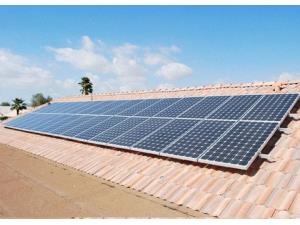



Date:02/11/20
 In a new report, the International Energy Agency (IEA) says solar is now the cheapest form of electricity for utility companies to build. That’s thanks to risk-reducing financial policies around the world, the agency says, and it applies to locations with both the most favorable policies and the easiest access to financing. The report underlines how important these policies are to encouraging development of renewables and other environmentally forward technologies.
In a new report, the International Energy Agency (IEA) says solar is now the cheapest form of electricity for utility companies to build. That’s thanks to risk-reducing financial policies around the world, the agency says, and it applies to locations with both the most favorable policies and the easiest access to financing. The report underlines how important these policies are to encouraging development of renewables and other environmentally forward technologies.
Carbon Brief (CB) summarizes the annual report with a lot of key details. The World Energy Outlook 2020 “offers four ‘pathways’ to 2040, all of which see a major rise in renewables,” CB says. “The IEA’s main scenario has 43 [percent] more solar output by 2040 than it expected in 2018, partly due to detailed new analysis showing that solar power is 20 [to] 50 [percent] cheaper than thought.”
The calculation depends on financing figures compared with the amount of output for solar projects. That means that at the same time panel technology gets more efficient and prices for basic panels continue to fall, investors are getting better and better financing deals. CB explains:
“Previously the IEA assumed a range of 7 [to] 8 [percent] for all technologies, varying according to each country’s stage of development. Now, the IEA has reviewed the evidence internationally and finds that for solar, the cost of capital is much lower, at 2.6 [to] 5.0 [percent] in Europe and the US, 4.4 [to] 5.5 [percent] in China and 8.8 [to] 10.0 [percent] in India.”
So the statistic “20 to 50 percent cheaper” is based on a calculus of companies building solar projects, not something that has throughput for consumers or even solar homeowners. But it’s still a big deal, because the cost to build power plants is a major part of why so much of the world has stuck with coal and gas power. With the new, lowered cost of capital, solar’s cost per megawatt has fallen almost completely below both gas and coal worldwide. (These statistical models get into some detail, but very local results are different, of course.)
It’s official: Solar is the cheapest electricity in history
 In a new report, the International Energy Agency (IEA) says solar is now the cheapest form of electricity for utility companies to build. That’s thanks to risk-reducing financial policies around the world, the agency says, and it applies to locations with both the most favorable policies and the easiest access to financing. The report underlines how important these policies are to encouraging development of renewables and other environmentally forward technologies.
In a new report, the International Energy Agency (IEA) says solar is now the cheapest form of electricity for utility companies to build. That’s thanks to risk-reducing financial policies around the world, the agency says, and it applies to locations with both the most favorable policies and the easiest access to financing. The report underlines how important these policies are to encouraging development of renewables and other environmentally forward technologies.Carbon Brief (CB) summarizes the annual report with a lot of key details. The World Energy Outlook 2020 “offers four ‘pathways’ to 2040, all of which see a major rise in renewables,” CB says. “The IEA’s main scenario has 43 [percent] more solar output by 2040 than it expected in 2018, partly due to detailed new analysis showing that solar power is 20 [to] 50 [percent] cheaper than thought.”
The calculation depends on financing figures compared with the amount of output for solar projects. That means that at the same time panel technology gets more efficient and prices for basic panels continue to fall, investors are getting better and better financing deals. CB explains:
“Previously the IEA assumed a range of 7 [to] 8 [percent] for all technologies, varying according to each country’s stage of development. Now, the IEA has reviewed the evidence internationally and finds that for solar, the cost of capital is much lower, at 2.6 [to] 5.0 [percent] in Europe and the US, 4.4 [to] 5.5 [percent] in China and 8.8 [to] 10.0 [percent] in India.”
So the statistic “20 to 50 percent cheaper” is based on a calculus of companies building solar projects, not something that has throughput for consumers or even solar homeowners. But it’s still a big deal, because the cost to build power plants is a major part of why so much of the world has stuck with coal and gas power. With the new, lowered cost of capital, solar’s cost per megawatt has fallen almost completely below both gas and coal worldwide. (These statistical models get into some detail, but very local results are different, of course.)
Views: 277
©ictnews.az. All rights reserved.Similar news
- Azerbaijani project to monitor disease via mobile phones
- Innovative educational system to be improved under presidential decree
- NTRC prolongs license of two TV and radio organizations for 6 years
- Azerbaijan establishes e-registry for medicines
- Azerbaijani museum introduces e-guide
- Nar Mobile opens “Nar Dunyasi” sales and service center in Siyazan city
- International conference on custom electronic services held in Baku
- OIC secretary general to attend COMSTECH meeting in Baku
- Azerbaijan develops earthquake warning system
- New law to regulate transition to digital broadcasting in Azerbaijan
- Azerbaijani State Social Protection Fund introduces electronic digital signature
- Intellectual traffic management system in Baku to be commissioned in December
- Tax Ministry of Azerbaijan started receiving video-addresses
- World Bank recommends Azerbaijan to speed up e-service introduction in real estate
- Azerbaijan to shift to electronic registration of real estate





















